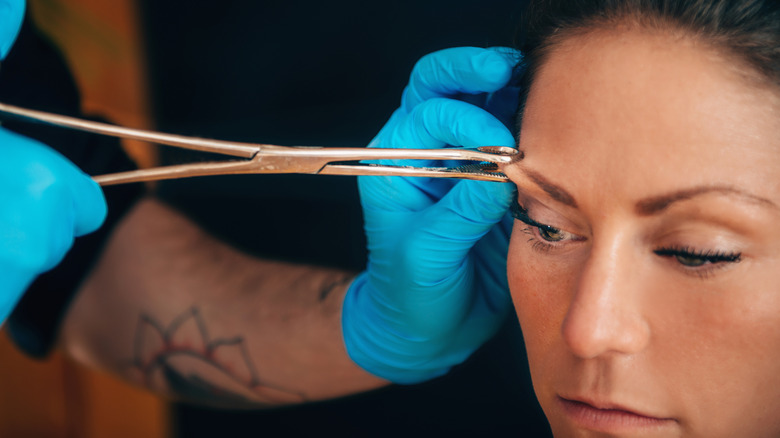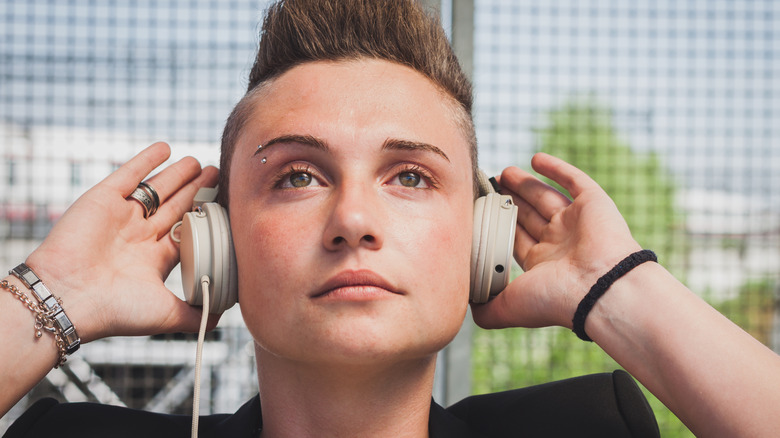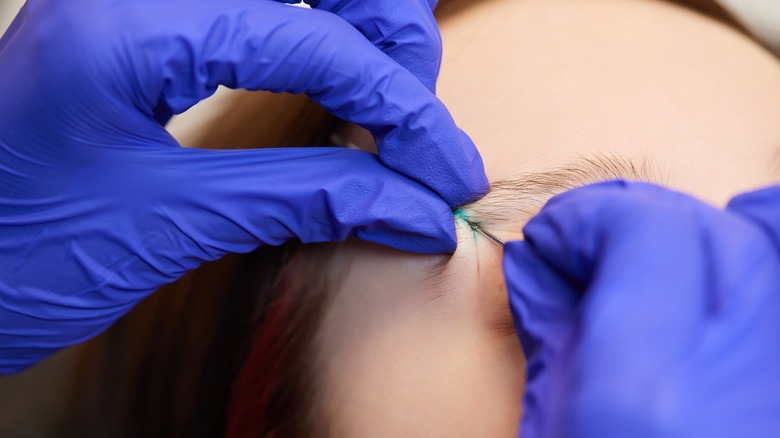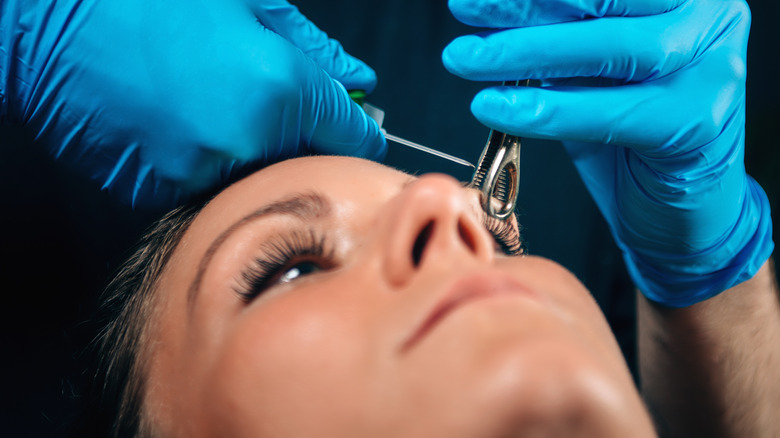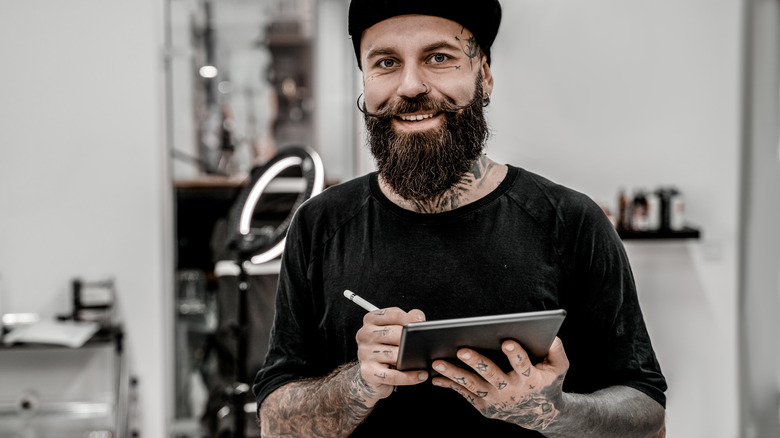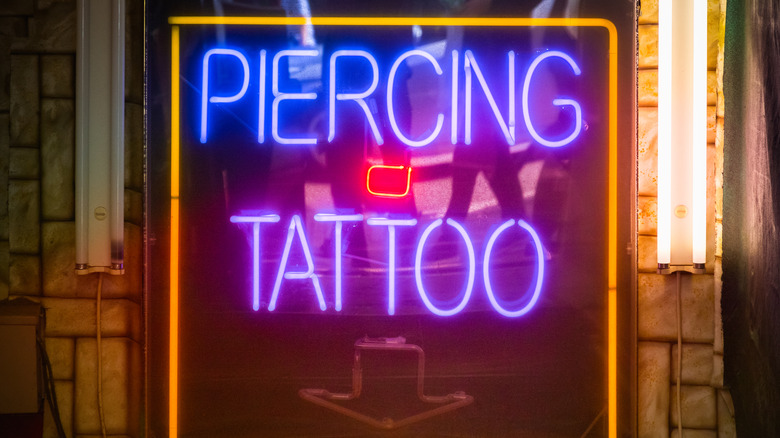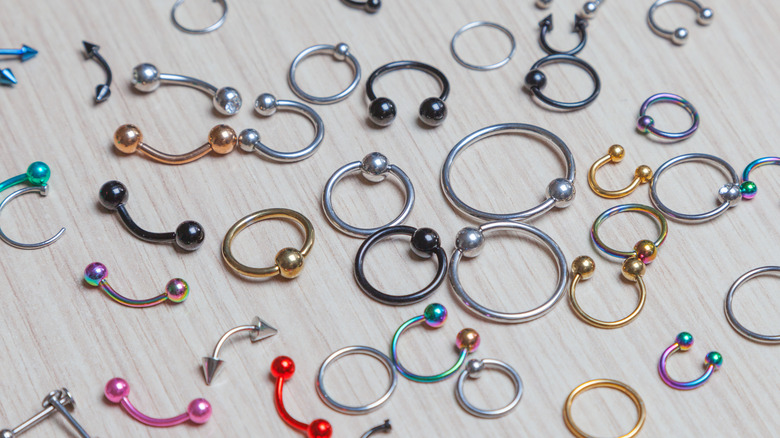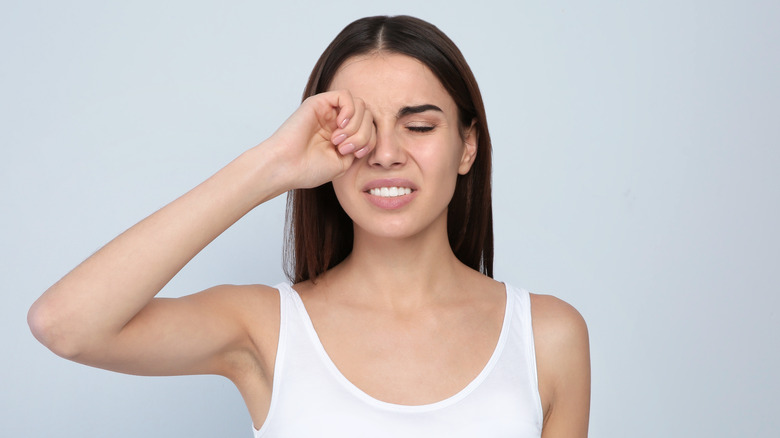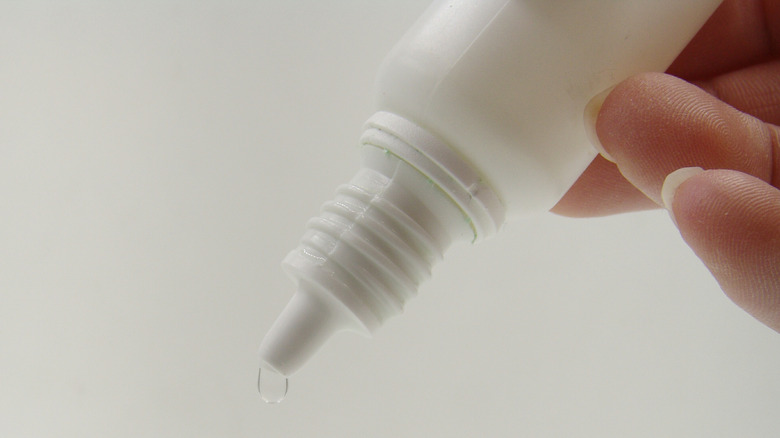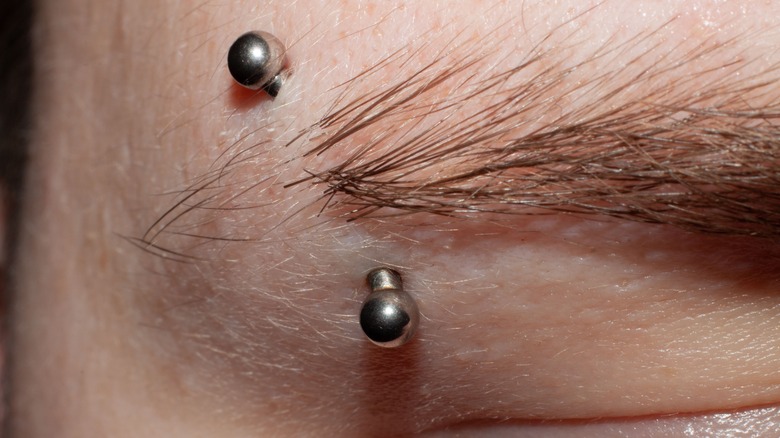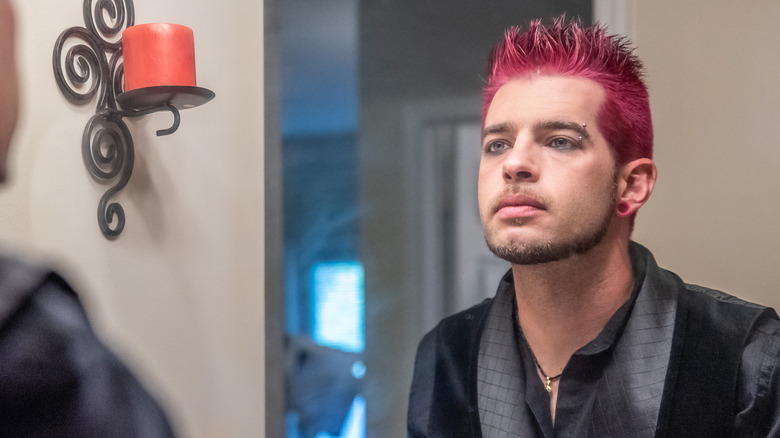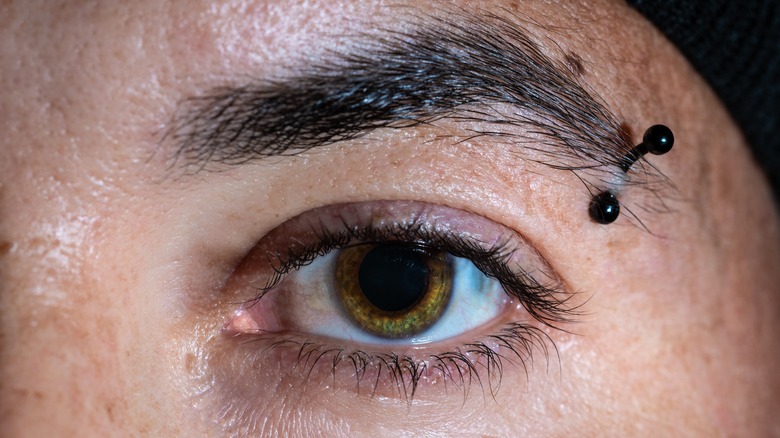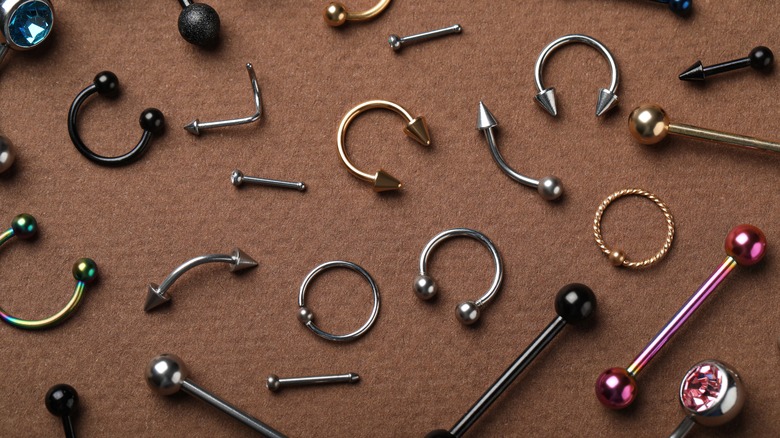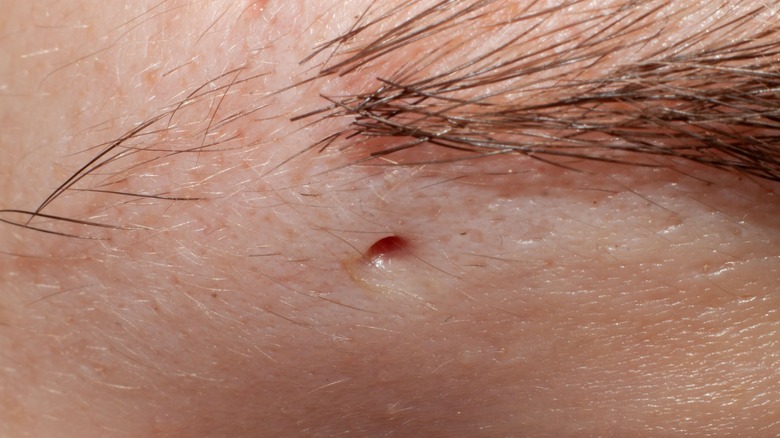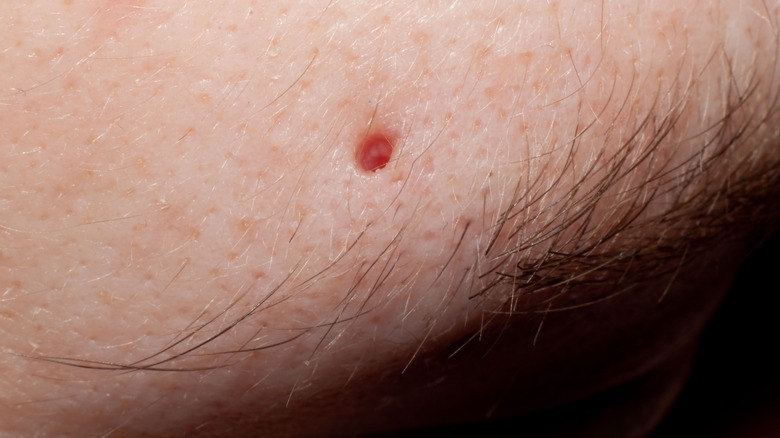Everything You Should Know Before Getting An Eyebrow Piercing
Eyebrow piercings have always been associated with music and counterculture. Body modification expert David "DaVo" Wilkins shares, "[eyebrow piercing does] have its roots in the Punk Rock Subculture of the 1970s. Though the practice was often self-done with whatever sharp object that could be crammed through the tissue and then closed ... The more permanent modern version seems to have come about during the late 1980s and then gained popularity through the 'Alternative' Music of the early 1990s."
Since the '90s, the piercing trend of eyebrow piercings has steadily grown in popularity, and they're now just as common as any other facial piercing. The iconic eyebrow piercing is usually a vertical piercing at the outer edge of the eyebrow adorned with either a curved barbell or a ring. But any piercing that goes through the skin around the eyebrow is considered an eyebrow piercing. Other popular variations include a horizontal piercing above the eyebrow, multiple vertical piercings, a vertical piercing at the middle of the eyebrow, or a vertical piercing at the inner edge of the eyebrow, often called a bindi piercing.
If you're considering one of these trendy piercings, here are a few things you should know before you book an appointment.
Decide if an eyebrow piercing is right for your face
In his decades of experience, Body modification expert DaVo Wilkins has learned one crucial lesson about eyebrow piercings — they just don't work for everyone's body. Wilkins shares, "The reality is that it all comes down to the structure of the brow, placement and the jewelry worn in the piercing. An ideal candidate for the piercing should have a brow that is made up of loose padded skin that is easily lifted from the skull."
For an eyebrow piercing to heal properly and stay in, there needs to be enough tissue around the eyebrow so that the jewelry isn't too close to the skull, and the skin isn't pulled too tight around the jewelry. Wilkins provides an easy way to test if an eyebrow piercing will work for you. Pinch the skin around your eyebrow where you want the piercing done. If the skin feels thick, soft, and loose, then you probably have enough tissue to accommodate a piercing.
If you want to make sure that an eyebrow piercing fits with your overall facial structure, try putting a fake ring where you want the piercing, and wear the fake one for a bit before you commit.
How painful is an eyebrow piercing?
If you're sure an eyebrow piercing will look amazing on you, you'll still need to decide whether you can handle the pain of a needle going through the skin of your eyebrow before you end up in a piercer's chair. Luckily, eyebrow piercings are one of the least painful piercings you can have done.
Many people liken getting their eyebrow pierced to the feeling of a bad pinch. Virginia R., a customer, told Body Candy, "it's like getting a shot or something, it's gonna sting a little bit." Whether it feels like a pinch or a sting, it may momentarily hurt enough to make your eyes water a little. Customer Saria O. said, "this was only a two or three out of ten on the pain scale," so expect to barely feel the pain. If you've never had a body piercing before, an eyebrow piercing is a good place to start discomfort-wise.
How eyebrow piercings are done
When you arrive at the piercing shop, your piercer will go over a bunch of information like the risks of the piercing, the aftercare instructions, and what to do if anything goes wrong. They'll also ask for your ID to make sure you're old enough to get pierced, which varies per state. Then, you'll sign consent forms.
Once all the admin stuff is done, the piercer will take you to their piercing station and sit you down in a piercing chair or lay you down on a table similar to a massage table. They'll use a special marker to put two dots on your eyebrow, which represent the places the needle will go in and come out. The piercer will ask you if the dots are where you want to get pierced, just to be sure. They'll also ask you if you want a barbell or a ring and discuss which jewelry is the best fit for your face.
Then, the piercer will put on gloves and open sterile equipment or get equipment out of a sterilizing tool called an autoclave. Once all the equipment is ready, they'll clean off the skin and use a specialized clamp to grasp the skin around your eyebrow. They'll insert a hollow needle through your skin, and slide in the jewelry you've chosen. Finally, the piercer will clean the completed piercing.
Choosing your piercer
Once you've decided to get an eyebrow piercing, you'll need to choose where to get the piercing done. You could just head to Google and choose the piercing shop closest to you, but this isn't the best way to make sure that you end up at a safe shop with an experienced piercer. Instead, use the Association of Professional Piercers guidelines for choosing a piercer.
A shop's website should have a page with bios for each of the piercers, and those bios should include all their certifications. Be aware that not all states require piercers to be certified, but all good piercers should be certified in standard safety procedures, regardless of your state's laws. Once you find a piercer who looks good on paper, drop by their shop and talk to them. Ask questions about their procedures and safety guidelines. Then look around the shop. Is it clean? Is everyone wearing gloves when they touch equipment or pierce? Is everyone washing their hands? Is the equipment single-use or sterilized in an autoclave?
Ultimately, trust your instincts to decide whether the shop is the right fit for you. If it is, book an appointment!
Preparing for your appointment
Getting a piercing doesn't just involve showing up and getting a needle put through your skin. You should actually start preparing the night before your appointment. Stay hydrated that day, eat a good dinner, and make sure you get enough sleep. It's also important to stay sober the night before your appointment. Having any alcohol in your bloodstream during a piercing can impact the way your body will react, which can alter the way your body heals.
On the day of your piercing, have a small snack before you head to the shop. Some people get nauseous during piercings, so don't go on an empty stomach, but don't load up on food either. Make sure to plan your day so you have time before and after the piercing. If you're nervous about the time, you're more likely to be nervous during the procedure.
If you typically wear makeup around your eyebrows, it's fine to apply it the day of your appointment, but know that it will be wiped away before the piercing. Make sure to keep your hair out of your face, too. If you're feeling nervous about the piercing, practice some deep breathing exercises before and during the piercing.
Choosing your jewelry
You have a few different options for the jewelry that will be placed in the piercing. The most common jewelry for eyebrow piercings are curved barbells, rings, and twisters. Barbells and rings are just what they sound like, and a twister is a straight or curved barbell with a twist at each end, giving it a unique look. Rings typically come in three varieties: a ring with a bead in the middle, a ring with two beads on the end, or a ring with a clasp.
Most piercers will suggest a curved barbell or ring since these shapes fit best in the eyebrow and facilitate proper healing. Some piercers have strong opinions about whether curved barbells or rings are better for eyebrow piercings, while others think they're both just as good. Most often, piercers use a ring with a bead in the middle.
Piercing jewelry can be made of surgical steel, titanium, or gold. Most piercers will use surgical steel or titanium. These metals are least likely to cause allergic reactions. The piercer will have a variety of jewelry in stock for you to choose from.
Risks from eyebrow piercings
Though eyebrow piercings are pretty safe, there are some risks you should know about before you get one done. Complications like inflammation and bruising are actually fairly normal after an eyebrow piercing because the skin around the eyes is particularly sensitive and fragile (per All About Vision). Eyebrow piercings may also tear the skin more easily than other locations where the pierced tissue is thicker and sturdier. Sometimes, an eyebrow piercing will cause scarring or a keloid, a raised area of scar tissue.
The biggest risk you face when getting your eyebrow, or any other location, pierced is an infection. Bacterial infections can happen if the equipment used to pierce your eyebrow wasn't properly sterilized. However, they can also happen if the piercing isn't cleaned often or well during the healing process. Less often, an infection around your eyebrow piercing can be caused by contact with a virus. In rare cases, an infected eyebrow piercing can spread into the eye and damage it.
Another rare complication of eyebrow piercings is nerve damage. There are several crucial nerves in the face, and if they're damaged during the piercing process, it can result in permanent nerve damage. However, an experienced piercer will never pierce you near a nerve, and if they have concerns, they should refuse to perform the piercing.
Caring for your eyebrow piercing
After your eyebrow piercing is done, your piercer will give you detailed instructions on how to clean the piercing. Though some piercers have their own recommendations based on their experiences, the basics are always the same. Wash your eyebrow piercing with saline solution twice a day, minimum (per Authority Tattoo). Though saline solution is basically salt water, it has a specific ratio of water and salt. Don't just mix salt and water and wash your piercing with that. Buy saline solution at the store or ask your piercer how to make saline solution at home. Some piercers recommend specific piercing cleaning solutions, but regular saline will work just fine.
The easiest way to clean your piercing is to put saline on a paper towel or a clean washcloth and gently press it on the piercing for about 10 minutes. Don't use cotton swabs or cotton balls because tiny fibers can peel off and stick in the piercing or on the jewelry. If you want a deeper clean, you can fill a bowl with saline solution and rest the side of your face in the bowl to fully submerge the piercing. This level of cleaning usually isn't necessary unless you suspect your piercing is getting infected.
The healing process
Even if a piercing looks healed after a few weeks, it's still not fully healed. That's why it's important to follow the cleaning procedures for the entire time stated in the aftercare instructions. An eyebrow piercing typically takes about two months to heal. However, some people heal faster and some heal slower. So, your eyebrow piercing could be healed after six weeks, or it could still be healing four or five months after you got it pierced.
A piercing is a wound, so your body responds to a piercing the same way it would to an injury. That means the area will bleed, swell, and bruise. Usually, this doesn't last for very long. Most people will have swelling and bruising around the piercing for a few hours, but it can last for a few days. It's rare, but some people who tend to bruise easily and get bad bruises can get a black eye from the piercing. You can take Ibuprofen and gently apply an ice pack to lessen the swelling and bruising, but nothing will make them go away other than time.
Redness around the piercing, white or yellow discharge, and even little bumps around the piercing can be normal, too, though these are often signs that the piercing is irritated and not healing properly.
What to do if you think something's wrong
If you clean your eyebrow piercing twice a day and protect it from dirt, bacteria, and irritants, you probably won't get an infection. However, it's important to know the signs of an infection and the solutions, just in case. The first sign of an infection is often redness and swelling around the piercing that starts weeks or even months after you got pierced. The skin may also be warm to the touch. Funky discharge is also a distinct sign of infection: White or even yellow discharge is normal, but if the discharge is greenish, darker yellow, tinged with blood, or smells awful, that means your piercing is infected.
If you're worried that your eyebrow piercing is infected, you can always call your primary care physician. However, most infections can be treated at home. Though removing the jewelry from your piercing may seem like the obvious move, don't do it! This causes your piercing to close up, which traps the infection inside your skin. Keep the jewelry in so your piercing stays open and allows disinfectants to get into the piercing. Soak your piercing in hot salt water several times a day to clean it and draw out the infection.
Eyebrow piercing rejection and migration
Any piercing is essentially a wound inflicted on the body, and the jewelry placed in the piercing isn't really supposed to be in the body. Usually, the body heals the wound around the jewelry and there aren't any further issues. Sometimes the body's natural defense systems see the jewelry as a "foreign object" that needs to be expelled so the body can heal. When this happens, your body's defense system slowly pushes the jewelry through the skin, a process called migration, until the jewelry actually falls out. This is called rejection.
Rejection most commonly happens with surface piercings — piercings that only go through a small amount of skin. Since eyebrow piercings are surface piercings, they're more likely to get rejected than other piercings. But that doesn't mean that eyebrow piercings will always get rejected. Elayne Angel, author of "The Piercing Bible — The Definitive Guide to Safe Body Piercing," shares, "Eyebrow piercings have an undeserved reputation for a high rejection rate. When appropriate jewelry is properly placed in pliable tissue, rejection is rare. Complications often occur if the brow is not sufficiently padded, which causes excessive pressure of jewelry against the bone. Wearing jewelry that is too heavy for the delicate tissue, or straight bars instead of curved ones, can also be problematic."
Changing the eyebrow jewelry
One of the best things about having a piercing is changing the jewelry to match your outfit or achieve a certain aesthetic. But changing the jewelry in your eyebrow piercing can come with risks, especially if you don't wait long enough or take the right precautions. Wait until the piercing is fully healed and ensure that the new jewelry you buy is the same size as the jewelry inserted by your piercer. They should have told you the size, but if they didn't or you forgot, call and ask.
When you've got your new jewelry and you're ready to put it in, start by washing your hands thoroughly with soap and warm water. Then put some warm water on a cotton swab and gently rub the openings of your piercing. This softens the skin to make it easier to insert the jewelry. Take the ball off the end of the jewelry in your piercing, then put a water-based lubricant on the jewelry to make it easier to get it out. Slowly pull the jewelry out of your piercing, then clean the piercing site with saline solution.
Take the ball off one end of the new jewelry and apply the lubricant. Then gently slide the jewelry into your piercing. Put the ball back on, and clean the piercing with saline solution again.
Removing an eyebrow piercing temporarily
Sometimes, you'll need to take your eyebrow ring out temporarily, like for a formal event or to play sports. However, taking out your piercing, even for a short period of time, comes with risks. Piercings can begin to close very quickly when the jewelry is removed, sometimes, after just a few minutes. This can happen to any piercing, regardless of how long it's been since you got it done.
There are a few ways to prevent this from happening. If you're worried about your eyebrow jewelry getting pulled out while playing sports, you can put a piece of athletic tape over the piercing so it's less likely to get snagged. If you need to hide your piercing because it's not appropriate for a certain setting or event, consider putting in a retainer. These are small, clear pieces of jewelry that can be inserted in piercings to keep them open. They're made of plastic, so they won't interfere with medical equipment like CAT scans or MRIs either.
If you absolutely have to take your jewelry out, know that you're taking the risk of your piercing closing up, and put the jewelry back in as soon as possible.
Taking out your eyebrow piercing for good
Many people don't keep their eyebrow piercings forever. For various reasons, they eventually take out the jewelry and let the piercing close for good. If you do decide to remove your eyebrow piercing, all you have to do is take out the jewelry and leave it out. The holes will naturally close on their own. It can take a few months for the piercing to completely close, so make sure you're cleaning it regularly and thoroughly while it's healing.
There's a good chance you'll have two small scars where the holes were made in your skin. The best way to minimize scarring is to make sure that your eyebrow piercing doesn't get infected at any point. If you take care of your piercing, clean it regularly, and don't play with it, which traumatizes the skin and increases the buildup of scar tissue, then your scars should be barely noticeable.
If you don't like how the scars look once the piercing is fully closed, you can apply a scar cream to try and minimize the appearance.
